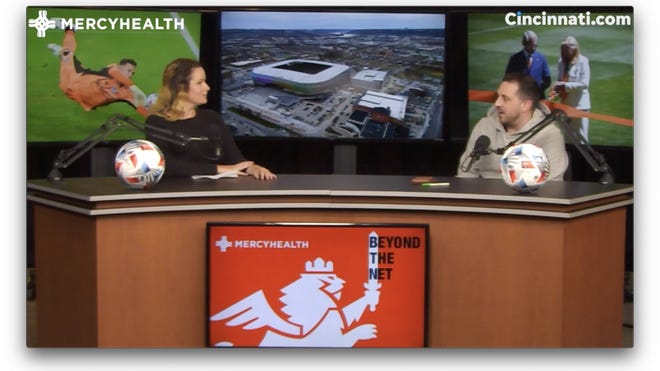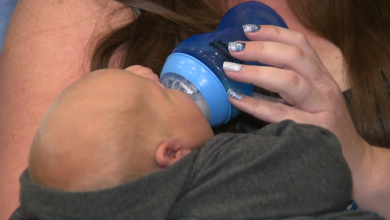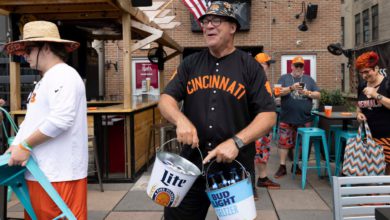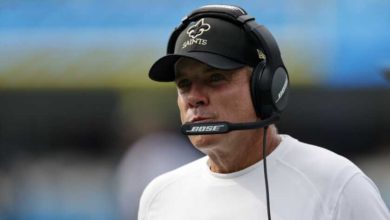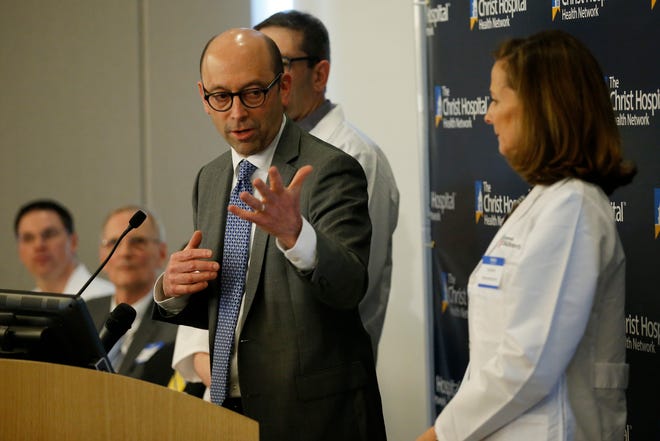

Dr. Richard Lofgren remembered the meeting, early on as the crisis bore down, when the leaders of the Cincinnati area's hospitals each presented plans for how each would address the novel coronavirus. They were solid plans, even elegant. They had plenty of plans.
Then Michael Fisher spoke. Words from the president of Cincinnati Children’s Hospital Medical Center always carried extra weight, but Fisher's recommendation had not been done before. Break down walls, and unify, with one plan. Now.
"He asked us to do better. It was a fateful moment,” said Lofgren, president and chief executive officer of UC Health. “We needed to work together as collaborators.”
[ Sign up for the free Coronavirus Watch newsletter to get the latest on the Cincinnati region ]
That choice built an unprecedented network among fierce competitors amid crisis that could well have been the edge that kept the Cincinnati region from an even heavier burden from COVID-19. Federal officials come into town to see how the systems harnessed their teams with public health and other entities to pull together.
Out of Fisher’s March 2020 appeal, “We were able to go on offense, on short order, and it was impressive to watch,” said Mark Clement, president and CEO of TriHealth. “The community should feel really good at how their health care systems put the public health first. … We agreed in multiple conversations, there’s nothing in fighting a pandemic that creates a competitive advantage.”
At about the same time, UC Health nurse Katie Walz ended her 12-hour shift in the intensive care unit. She slipped her face mask into a paper bag for reuse. The virus was like nothing she’d seen in her three years nursing. That first COVID-19 patient, a man, made it all real, “and then, it just, I don’t know, it seemed to be the main focus of our lives at work, at home, it was just everywhere.”

Taking notes on gum wrappers
Mike Abrams, president and CEO of the 240-member Ohio Hospital Association, said the moment he knew the health crisis would be gigantic came one night while he was in Dayton. He had to drop off his family at a restaurant while he took an urgent call from Gov. Mike DeWine, "and I was in the car for 45 minutes, grabbing for gum wrappers, Kleenex, any piece of litter I could find to write things down.”
For weeks, Lofgren took calls dawn to dark, and, “One night, I turned to my wife and said if sitting is the new smoking, I did five packs today.”
Hospitals post-pandemic: Six changes you’ll see in Cincinnati health care as crisis ebbs
The pandemic opened with the CEOs collaborating on acquiring more personal protective equipment for the staff and community, at profiteering costs. “On the phone six hours a day trying to get PPE for a month straight, and we were not the only ones,” said Garren Colvin, president and CEO of St Elizabeth Healthcare, the major provider in Northern Kentucky. He paid $10 each for masks that once cost a dollar.
“The most important meeting of the day was the PPE meeting,” Colvin said, “to understand how much quantity was on site, how much you anticipated that day, that week.”

A key revelation of the collaboration was that the region has a lot more hospital beds than anyone knew, even as the pandemic surged in the summer and more dangerously at year’s end. The region’s leaders scrapped early plans for the Duke Energy Convention Center as an auxiliary facility. The more than 20 hospitals in the region’s 14 counties realized they could expand again and again.
Colvin at St. Elizabeth said the collaboration opened channels to “partner and work together, versus how we would be competing, on how we’re improving the infection rate, and the mortality rate, and how we can do all the things that make a difference. No one is saying, how can I increase my volume? We were too busy fighting a disease to worry about competition.”

Through the summer into the fall, Walz nursed ICU patients with COVID-19 with eight or nine intravenous medications to be delivered simultaneously. “You’re pretty much constantly doing something for them,” she said. “We all kind of learned and grew together. There were tricks, at one point, like we kept the IV poles outside the room, with long tubing to the patient.” The arrangement gave Walz and her colleague more room to maneuver and reduced their own risk of infection.
Biology and sociology
The hospitals came together under the umbrella of their unofficial chamber of commerce, the Health Collaborative. Craig Brammer, its president and CEO and a longtime industry observer, said that talking as often as they did, the CEOs, financial officers, medical chiefs and other leaders came to an understanding.
“The pandemic has shown us in stark terms that some of the problems of course are based in biology, but they’re really sociology problems,” he said. The collaboration “has really sharpened the focus on that. The pandemic has been remarkably selective in terms of who it affects the most, and the impact on Black and brown communities is undeniable.”
The pandemic “exposed the weaknesses, and the pre-existing problems plus the health care disparities,” Lofgren said.

The systems tackled some problems with individual initiatives. Bon Secours Mercy Health announced in December that it would sponsor eviction and foreclosure prevention programs in the Bond Hill and Roselawn neighborhoods as a health measure, said David Fikse, president of Mercy Health-Cincinnati. "How do you prevent the disease and stop the disease from progressing? There is a good body of work that you will spend fewer dollars in the long run if you address housing.”
Inside the ICU, death kept coming. Once, Walz had two men as patients, both married with young children, who were not going to make it. “Each time, the wives turned to me and asked, ‘What am I supposed to do? What am I supposed to tell my children?’ I had no answer for that. How am I supposed to answer that?”
Moving the needles - literally
The collaborations came in small ways, too. In early January, Health Collaborative spokeswoman Christa Hyson got a call from Cincinnati Children’s offering a shipment of needles it couldn’t use, free. Hyson said such a plea was unheard of before the pandemic. She found a taker at the TriHealth vaccine clinic in Norwood and delivered them herself.
“I knocked on the door,” Hyson recalled, “a nurse opened it, and said, ‘Santa!’ ”
The hospital leaders said their workers lived with immense stress. Physically, said Colvin of St. Elizabeth, he feels fine, “but from a mental health perspective, you’re knowing you’re making decisions that affect not only your 10,000 associates but their families. … Seeing how the community was suffering, that made a difference for getting us all through. We all are suffering.”
A month ago, speaking at a memorial service to mark one year since St. Elizabeth's first COVID-19 patient, Colvin struggled back tears at times as he spoke to several nurses, a few doctors and a few other staff members who had gathered at St. E's Fort Thomas. "You've permitted so much healing. Make sure you take the time to heal yourselves," he told them.

Misinformation complicated the work. Fikse said doubters drove through Mercy Health hospital parking lots taking video of empty spaces, apparently to show the pandemic didn’t exist. The lack of cars, Fikse said, was the result of stringent visitation controls.
“We’ve had issues when masks were mandatory, and our associates did extremely well when there were some very difficult positions they were put into,” Fikse said. “They had to learn how to de-escalate from that.”
Abrams of the OHA said the state’s hospitals had to collaborate on many levels from the start because Gov. Mike DeWine was calling for everyone’s input, right away. But the Cincinnati experiment worked well enough to establish a chance at permanence.

“The governor would call and say, ‘Get all your infectious disease people together, I have questions and you have five minutes’ notice,” he said. “A lot of these people have met each other for the first time through this crisis. … They have kind of learned that it’s OK to talk to the competitor across town about certain things or a competitor across the state. They want the pandemic to be over, but they’re going to miss each other.”
Hospitals post-pandemic: Nearly $700 million from feds helped region's health care
Cincinnati Children's Fisher said he didn’t create the collaboration. He pointed out the hospitals have been moving in that direction, and with a new virus, the destination had arrived. “There are many privileges and gifts associated with service to children,” he said. “This job is one of the unique roles in this community, which allows me to work and partner with all the adult institutions in town.”
Brammer of the Health Collaborative said the effort put the Cincinnati region “in pretty good shape,” although he estimated another 18 months may pass for crisis conditions in the hospitals to recede. The biggest challenge now, he said, will be maintaining the hospital workforces that did all the hard work on the ground and are coping with post-traumatic stress and other work-related health problems.

Katie Walz was the first UC Health worker to get a COVID-19 vaccination. This year, she has been picking up extra shifts at the hospital, and she’s noticed new faces among the nursing ranks.
“I really feel for the nurses who that started right out of school. I can’t imagine not having been a nurse before and then . . . Welcome!”
Walz said she was feeling burnout, and sometimes, she thinks about another line of work. “I don’t have right now something else that I want to do, so, maybe. But I think I probably will stick around. I’m probably a lifer.”
Source link

